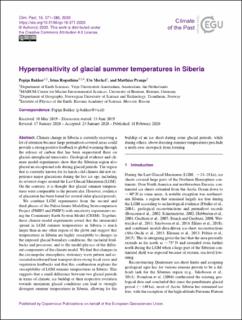| dc.contributor.author | Bakker, Pepijn | |
| dc.contributor.author | Rogozhina, Irina | |
| dc.contributor.author | Merkel, Ute | |
| dc.contributor.author | Prange, Matthias | |
| dc.date.accessioned | 2022-09-26T08:02:37Z | |
| dc.date.available | 2022-09-26T08:02:37Z | |
| dc.date.created | 2021-02-07T12:24:52Z | |
| dc.date.issued | 2020 | |
| dc.identifier.citation | Climate of the Past. 2020, 16 (1), 371-386. | en_US |
| dc.identifier.issn | 1814-9324 | |
| dc.identifier.uri | https://hdl.handle.net/11250/3021182 | |
| dc.description.abstract | Climate change in Siberia is currently receiving a lot of attention because large permafrost-covered areas could provide a strong positive feedback to global warming through the release of carbon that has been sequestered there on glacial–interglacial timescales. Geological evidence and climate model experiments show that the Siberian region also played an exceptional role during glacial periods. The region that is currently known for its harsh cold climate did not experience major glaciations during the last ice age, including its severest stages around the Last Glacial Maximum (LGM). On the contrary, it is thought that glacial summer temperatures were comparable to the present day. However, evidence of glaciation has been found for several older glacial periods.
We combine LGM experiments from the second and third phases of the Paleoclimate Modelling Intercomparison Project (PMIP2 and PMIP3) with sensitivity experiments using the Community Earth System Model (CESM). Together, these climate model experiments reveal that the intermodel spread in LGM summer temperatures in Siberia is much larger than in any other region of the globe and suggest that temperatures in Siberia are highly susceptible to changes in the imposed glacial boundary conditions, the included feedbacks and processes, and to the model physics of the different components of the climate model. We find that changes in the circumpolar atmospheric stationary wave pattern and associated northward heat transport drive strong local snow and vegetation feedbacks and that this combination explains the susceptibility of LGM summer temperatures in Siberia. This suggests that a small difference between two glacial periods in terms of climate, ice buildup or their respective evolution towards maximum glacial conditions can lead to strongly divergent summer temperatures in Siberia, allowing for the buildup of an ice sheet during some glacial periods, while during others, above-freezing summer temperatures preclude a multi-year snowpack from forming. | en_US |
| dc.language.iso | eng | en_US |
| dc.publisher | European Geosciences Union | en_US |
| dc.rights | Navngivelse 4.0 Internasjonal | * |
| dc.rights.uri | http://creativecommons.org/licenses/by/4.0/deed.no | * |
| dc.title | Hypersensitivity of glacial summer temperatures in Siberia | en_US |
| dc.title.alternative | Hypersensitivity of glacial summer temperatures in Siberia | en_US |
| dc.type | Peer reviewed | en_US |
| dc.type | Journal article | en_US |
| dc.description.version | publishedVersion | en_US |
| dc.source.pagenumber | 371-386 | en_US |
| dc.source.volume | 16 | en_US |
| dc.source.journal | Climate of the Past | en_US |
| dc.source.issue | 1 | en_US |
| dc.identifier.doi | 10.5194/cp-16-371-2020 | |
| dc.identifier.cristin | 1887395 | |
| cristin.ispublished | true | |
| cristin.fulltext | original | |
| cristin.qualitycode | 1 | |

